Inis Mor is a popular location on our West of Ireland / Connemara tours. In this blog, we dive deeper into what makes Inis Mor, and the Aran Islands in general, so special and a great place to go hiking. So we hope that you enjoy this guide to hiking the Aran Islands.
The three landmasses comprising the Aran Islands make up what is perhaps the most well known archipelago in Ireland. Jutting out just past the mouth of Galway Bay, they are perfectly situated in terms of tourist access.
Getting to the Aran Islands
Visitors to Galway City and County Galway’s Connemara region can easily access the islands from the northerly approach of Rossaveel Harbour. Meanwhile way over on the other side of Galway Bay, the heavily touristed Cliffs of Moher in County Clare are just down the road from Doolin. It is from here that the smaller of the two islands (Inis Oirr and Inis Meain) can be readily accessed. The journey from Doolin is actually even shorter than that from Rossaveel. Travelling by land from Rossaveel to Doolin takes more than two hours, however thanks to various ferry services between the three islands and to and from the mainland, the ideal way to visit the West of Ireland is to literally island hop in the one direction.
Inis Mor
Inis Mor – literally, “Big Island” and of course the largest of the three – offers up brilliant hiking and cycling trails. For the purposes of this guide we’ll hone in on the sights here but don’t forget to check out the smaller two as well should time allow. The end of this post includes a quick overview of Inis Meain and Inis Oirr to whet your appetite. Those deciding to head off on their own two feet can expect to be treated to a different experience than that found back on the mainland. On a clear day, Kilmurvey Beach looks more like a turquoise paradise in the Mediterranean than a beach in Ireland! The island rises rapidly out of the sea, providing views back towards the mountains of Connemara, plus some magnificent sea cliffs crowned by the impressive Dun Aonghasa ring fort.
Starting from your arrival at Kilronan Harbour, walkers will head west across the long, thin island, before looping back along the southern side of Inis Mor to return to Kilronan for the evening. It’s possible to complete the circuit in one day (even quicker on a bike of course!) but those with a tent (and landowner’s permission) or a B&B booked further west on the island can break up the journey into two days. Here are the main sights to take in on your way:
Dun Eochla
This is your first sight heading west from Kilronan. The Irish word for fort, ‘Dun’ can be spotted on maps all over the country. However while most of the old earthen and stone ring forts are in varying states of disrepair, this one is particular immaculate and forms almost two perfect, concentric circles. A drone can be used to capture some awesome photos and videos from up above. The nearby lighthouse ruins shouldn’t be missed either.
Seal Colony
After walking for about one hour out of Kilronan you’ll be able to spot clusters of seals down along the rocks, often basking in the sunlight during the summer months. Don’t approach too close for safety’s sake – they are particularly big fellas – but feel free to take a few snaps before continuing on.
Kilmurvey Beach
After another half hour you’ll arrive at the insanely beautiful (especially when the sun’s out) Kilmurvey Beach. It’s white sand is more reminiscent of a beach in northeastern Australia, or as I said earlier, the Mediterranean. If it’s a warm day, I’d highly recommend jumping in for a quick dip. The Atlantic is sure to cool you down in a hurry and rejuvenate you for the rest of the day.
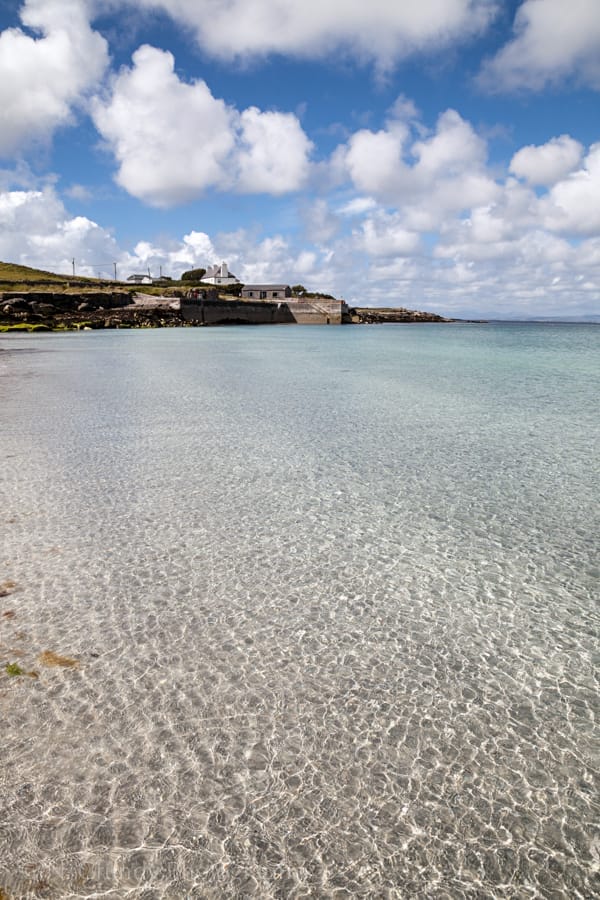
Kilmiurvey Beach, Inis Mor. – Photo credit www.nicholasgrundy.com
Teach Nan Phaidi Tea House
Every time I visit Inis Mor, I always cycle or walk straight over to Teach Nan Phaidi (‘Paddy’s House’) and enjoy an enormous lunch consisting of seafood, tea, cake, and a pint of Guinness to energise me for the afternoon. Just past Kilmurvey Beach, it’s the ideal stopover before heading uphill to the Dun Aonghasa Ring Fort.
Dun Aonghasa Ring Fort
Pronounced “Done Angus,” the epic ring fort boasts four-metre thick stone walls and a diameter of 50 metres – and it’s only a semi-circle as the high cliffs over the Atlantic slice it right down the middle. I’ve visited this sight a total of three times now, and each time I marvel at the craftsmanship evident in the perfect fits of the square-cut stones piled metres high. The complex also incorporates an outer barrier comprising a field full of rectangular, jagged stones rammed into the ground at differing angles. This obstacle helped hamper the progress of the enemy while also funnelling the attacking troops into certain areas, a tactic achieved by the dragon’s teeth and Spanish horse tank traps used in World War 2 (remember the opening scene of Saving Private Ryan, anyone?)
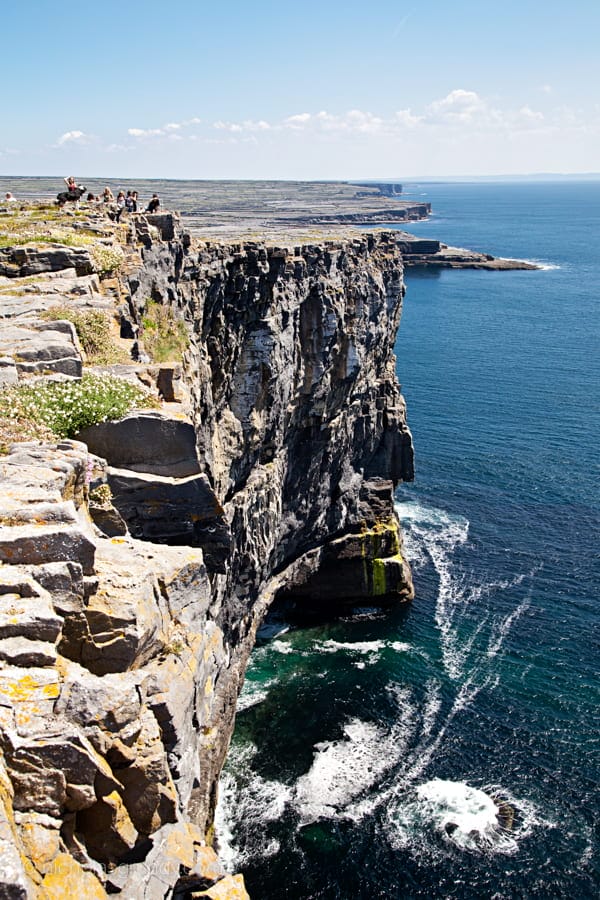
Cliffs at Dun Aonghasa Ring Fort. – Photo credit www.nicholasgrundy.com
Irish Speakers
By Irish here I mean Irish Gaelic, or more precisely, “Gaeilge.” I recently visited a remote island in County Cork and unexpectedly found myself surrounded by Irish speakers – something rarely seen on the mainland. Irish is still quite common among many of the local residents on all three of the Aran Islands. For those wishing to see and hear it in action, I’d highly recommend venturing off around the islands by foot. The local horse and trap drivers on the island can often be heard speaking Irish together as they await the return of their guests from Dun Aonghasa. By the way, the Irish word Inis, or island, is pronounced ‘Inish.’
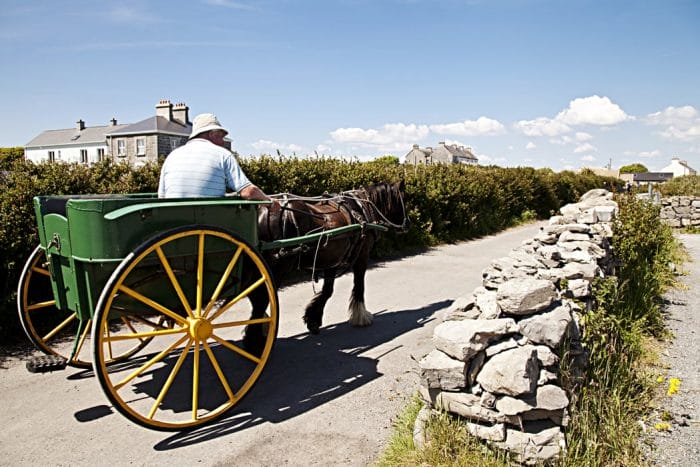
Irish-speaking horse and trap driver on Inis Mor. – Photo credit www.nicholasgrundy.com
Na Seacht dTeampaill (The Seven Churches)
This cluster of ruined churches is found another two kilometres west of Kilmurvey, Dun Aonghasa and Teach Nan Phaidi (the three of which are all more or less clustered together). As such, only the more adventurous walkers need head this far west on Inis Mor if time and conditions allow. The site is well worth a visit for those wishing to connect with the ancient history of the islands.
The Wormhole
This rectangular hole in the southern coastline of Inis Mor is only a twenty to thirty minute cross-country walk from Dun Aonghasa and is an absolute must for visitors. The sight can only be properly described via images, and can be viewed from three separate levels of cliffs (right up the top directly above it, half-way down towards it, and at the very bottom directly next to it.) Please be warned not to access the lowest level if there’s any risk of a high tide or inclement weather. And of course, never step too close to the edge! Should you fall in, there’s only a ladder to get you out during the Red Bull diving event!

The Wormhole, Inis Mor. – Photo credit www.nicholasgrundy.com
The Size
As you venture eastward from the Wormhole, if you haven’t realised it yet it will soon hit you just how big Inis Mor is. One of the largest islands off the coast of Ireland, it’s long, thin shape means there is plenty of distance to cover between sights. This in turn makes the island ideal for hikers and cyclists wishing to take in all the sights over a proper one or two-day trip.
The Trees
One of my favourite things about the island I always tell people is just how many – OK, just kidding. I’m pretty sure there isn’t a single tree on the island, or at least once you walk out of Kilronan anyway. Once you’ve been there you’ll get the joke, but seriously, pack your sunscreen as the windswept nature of the island must have prevented trees from ever growing there. Otherwise the farmers of yesteryear may have completely deforested the island for pastures. Either way, I’ll say it again, put sunscreen on even when you don’t think you need it. Every time I’ve visited the weather has been glorious, but I’ve seen visitors from Australia come away with a combination wind and sunburn thanks to the regular Atlantic breeze.
The Views
The southern side of Inis Mor is where you’ll find the highest elevations. As you traverse the clifftops you’ll be able to view the Cliffs of Moher to the southeast on the other side of Inis Meain and Inis Oirr. Back to the north you’ll have amazing views of the mountain ranges of Connemara as they meet the sea. Following the cliffs brings you to your last major sight before wheeling back to Kilronan Harbour.
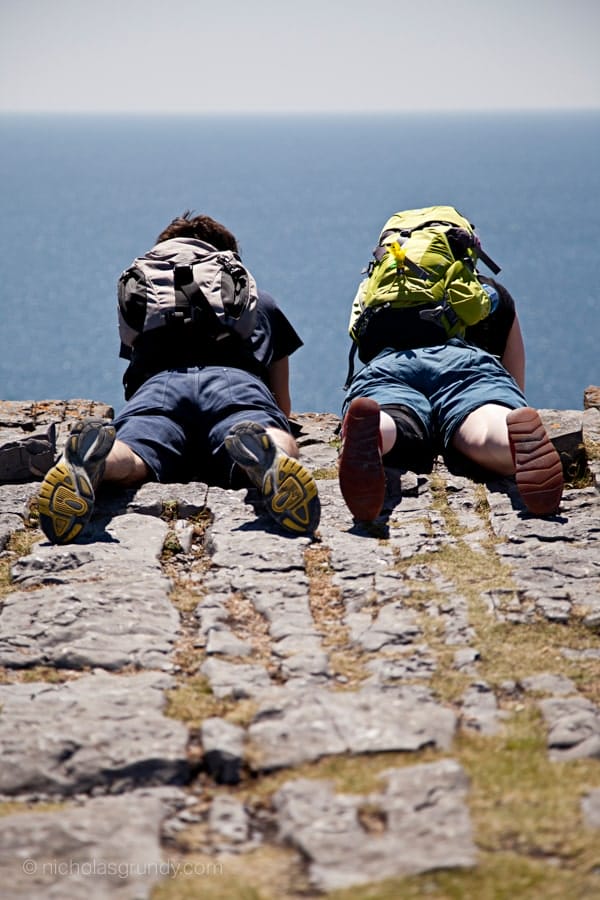
Hikers at the cliffs along the southern edge of Inis Mor. – Photo credit www.nicholasgrundy.com
The Black Fort
This ring fort is somewhat similar to Dun Aonghasa, however it’s slightly smaller and in a far more ruinous state. The fort is not as well waymarked and can be difficult to find, however the benefit of this is that you’ll have it all to yourself. Be very careful when accessing the inner section of the fortification, for you’ll need to rather gingerly walk between the crumbling edge of one stone wall and the side of the cliffs towering above the Atlantic as it seethes and rages below.
This is one of the best spots for photographers wishing to capture the raw power of the ocean, and is also brilliant for watching the sun set way out across the rippling waters. Every time I gaze westwards out across this stretch of the Atlantic I’m reminded of the countless emigrants who left Ireland decades and centuries ago in the hope of a better life. From this point on there’s nothing but a vast expanse of water until you finally hit the shores of America way over on the other side.
Teampall Bheanáin (St. Benan’s Church)
After you return to Kilronan from the Black Fort, you have the option of making a short side trip eastwards to St. Benan’s Church. The uniquely triangular-shaped oratory chapel is one of only a few such ruins found around Ireland. Historians believe it was the oratory of a hermit as it is rather small, only about 4.5 by 3.5 metres (15 by 11 feet). As such it is reputedly the smallest church in Ireland. Up on high ground, it’s another great spot to take in the sunset and admire the views.
Sights on the smaller two islands, Inis Meain and Inis Oirr:
Inis Meain and Inish Oirr
Officially Inish Meáin in Irish and meaning “middle,” this island is just that, the middle of the three islands in a neat row. Handily enough, it’s also the middle-sized of the three, although both Inis Meain and Inis Oirr (pronounced ‘ear’) are similar in size and significantly smaller than the big brother, Inis Mor. While both islands are rather similar to Inis Mor in nature, they do both offer up their own unique sampling of old ring forts and castles.
In particular visitors to Inis Oirr can check out O’Brien’s Castle before popping down to the coast to see the shipwreck of the Plassey. This particular sight was popularised in the opening sequence of the famous (or infamous) ‘Father Ted’ TV series. An aerial shot flies viewers across the top of the wrecked boat before the camera soon after crash lands onto the show’s main characters on their supposed home of ‘Craggy Island.’ Both Inis Meain and Inis Oirr are once again easily visited on foot or by bike, for as little as half a day each, or as part of a multi-night journey.
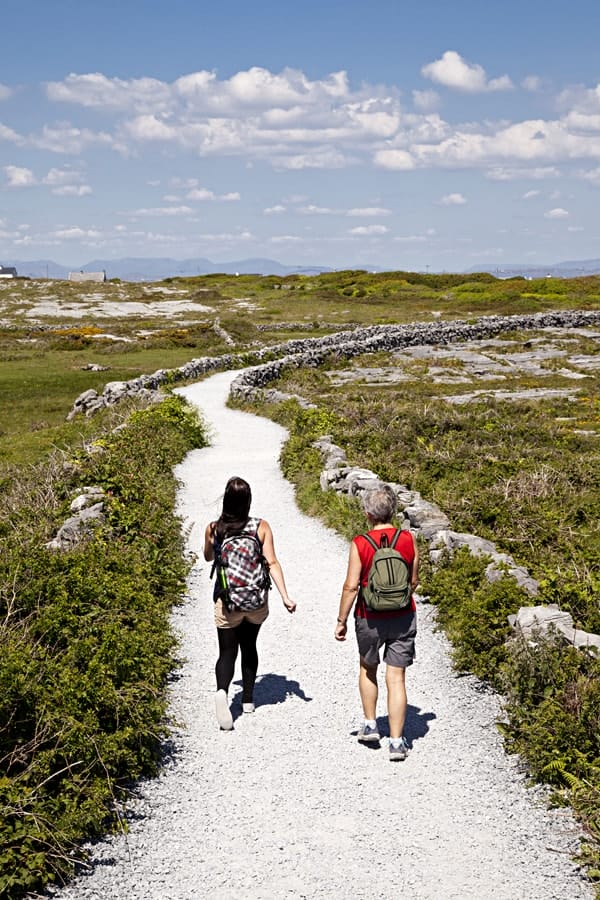
Walkers on the Aran Islands. – Photo credit www.nicholasgrundy.com
We hope that you enjoyed this guide to hiking the Aran Islands. For more information on our Connemara & West of Ireland hiking tours, just get in touch.


